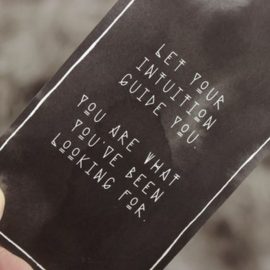

This article is an excerpt from the Shortform book guide to "The Happiness Trap" by Russ Harris. Shortform has the world's best summaries and analyses of books you should be reading.
Like this article? Sign up for a free trial here .
What does “fusion” mean in therapy? What’s the problem with “fusing” with your thoughts and what can you do to un-fuse?
When you mistake your thinking self—the part of you that thinks, judges, and acts—as a direct reflection of reality, you are in a state of “fusion” with your thoughts. The goal of cognitive defusion then is to acknowledge that your thoughts are simply stories the brain tells you in order to help you survive. There are a number of psychological techniques to do so.
Below, we’ll explore four cognitive defusion techniques that can help you disentangle from unhelpful thoughts.
4 Cognitive Defusion Techniques
Before exploring cognitive defusion techniques, it’s important to recognize their limits:
- The goal of these defusion techniques is not to eliminate negative thoughts, but to acknowledge thoughts for what they are: stories your brain tells you in order to live.
- The goal of these defusion techniques is not to make you feel good. You may have pleasant feelings while engaged in these techniques, but these feelings are incidental. It’s especially important not to mistake this incidental pleasure as the goal of defusion, since that mentality would turn defusion into a control strategy—and send you right back into the happiness trap.
- You may not always remember to perform these techniques exactly when you need them, but they are always available to you when you do recognize that you’re experiencing negative thoughts.
- These techniques aren’t perfect and there’s no guarantee they will work 100% of the time. If you try them and find they aren’t working, try to use your observing self to observe yourself believing that your thoughts are a direct reflection of reality.
- Finally, these techniques are intended for repeated use over time. Doing them once won’t be enough to train your observing self in the practice of defusion. But with enough practice, defusion should become something you can perform without these techniques.
| ACT Requires Practice Acceptance and Commitment Therapy is, above all, a practical approach to mental health and well-being. While understanding the principles of ACT may bring you some clarity and offer potential avenues forward, direct and repeated action is the only path toward psychological flexibility, the ability to acknowledge and productively deal with difficult thoughts and feelings. Thus, it’s essential to apply these techniques in your everyday life. They take little time to practice—from 30 seconds to five minutes a pop—and arm you with permanent tools for dealing with unwanted thoughts. It’s a good time investment. |
Technique #1: Distancing
The first technique Harris describes aims to train your observing self to notice the thoughts of your thinking self as thoughts rather than as reality. Follow these steps to practice distancing:
- Pick a powerful negative thought that you struggle with regularly.
- Take a moment and really believe the story that your thinking self is telling you. Observe yourself in a state of fusion with that thought.
- Now, try rephrasing the thought in your head by prefacing it with this phrase: “My brain is having the thought that…” For example, if your original thought was “I’m never going to succeed,” the rephrasing of that thought would be: “My brain is having the thought that I’m never going to succeed.”
You can experiment with this technique by adding more layers of separation to the beginning of the thought. For instance, you could rephrase your original thought this way: “My observing self is noticing that my brain is having the thought that I’m never going to succeed.”
| The Labeling Technique A variation on the distancing technique is called the labeling technique. Both exercises help you train your observing self to practice defusion. First, take a powerful recurrent negative thought and label it as either descriptive or evaluative. If a thought is descriptive, it derives from the five senses and can be independently verified. For instance, this thought is descriptive: “She has brown hair.” If a thought is evaluative, it extends beyond the senses into the realm of abstract evaluation. For example, this thought is evaluative: “She is beautiful.” As with the distancing technique above, labeling creates a distance between your thoughts and reality. Rather than adding layers of language between you and the thought, you’re adding a layer of judgment. |
Technique #2: Cartoon Characters
Harris’s next technique requires you to imagine a cartoon character saying your thoughts. Putting your thinking self’s commentary in another voice makes it easier to recognize that your negative thoughts are only sequences of words loosely bound together—and that helps you dissociate from those thoughts.
- Pick a powerful negative thought that you struggle with regularly.
- Observe yourself in a state of fusion with that thought.
- Now, try imagining a cartoon character with a distinctive voice saying the negative thought. For instance, imagine Donald Duck saying, “You’re never going to succeed.”
| The “Say It Slowly” Technique An alternative to this technique is called the “say it slowly” technique. To practice this, pick a recurring negative thought and slow the thought down in your mind, taking time to stretch out the syllables and put extra space between the words. Like the cartoon characters technique, the idea behind this exercise is that slowing down the pace at which a thought occurs and distorting it (almost as though you’re applying a voice filter to it) makes it more obvious that the thought is simply words you can speed up or slow down. |
Technique #3: Thanking Your Mind
Harris’s third technique helps you recognize that your thinking self’s running commentary is meant to keep you safe—even if it’s not the absolute truth. To practice this:
- Pick a powerful negative thought that you struggle with regularly.
- Observe yourself in a state of fusion with that thought.
- Express gratitude to your thinking self in whatever way you feel is appropriate. Just be sure the gratitude is heartfelt, not sarcastic.
If you struggle with this, remember that your thinking self is merely doing its best to keep you safe in a world it assumes poses many threats to your life. Even if you’re inconvenienced, hurt, or bothered by your brain’s attempts to keep you safe, acknowledge that it’s trying to work in your best interest. (Shortform note: In The Power of Now, Eckhart Tolle argues that your ego (which Harris would call your thinking self) is not acting in your best interest when it generates negative thoughts. Instead, Tolle says that the ego manufactures problems and abstract fears in an effort to keep you engaged with it and prevent you from connecting with your true self (your observing self).)
| The Pop-Up Mind Technique An alternative to thanking your mind is called the “pop-up mind” technique. While thanking your mind reminds you that your thinking self is well-intended, this technique emphasizes that the nature of the thinking self is automatic. Just as a website automatically delivers pop-up ads to your computer, your thinking self delivers thoughts to your awareness. Rather than feeling that you absolutely must click on the ad, the exercise reminds you that you can simply choose not to engage. Practicing this technique is fairly simple: Whenever you experience a negative or unwanted thought, imagine that the thought is an internet pop-up ad. Then, practice closing the ad. |
Technique #4: Television Images
Unlike the previous techniques, this technique is specifically designed to help you process negative images, not negative thoughts. Harris writes that this practice helps you recognize that you can radically recontextualize your painful image or memory until it loses its negative connotation and becomes a picture next to a thousand other pictures—ultimately harmless.
- Pick a powerful negative image, or sequence of images, that you often struggle with. Harris recommends limiting the scope of your chosen images to roughly 10 seconds in length.
- Observe yourself in a state of fusion with this image.
- Imagine the same image on a small screen. You can experiment with the image on the screen: Turn it black-and-white, fast-forward or reverse, make the image bigger or smaller, or imagine the image with a different set of colors.
- Add a soundtrack to the image or memory. Experiment with a number of unique sounds. You might try bluegrass music for five seconds then switch to R&B.
- Place the image in a new background or setting. For instance, you might start off outside of your childhood home, then the edge of an erupting volcano, then up into the clouds. The only limit is your imagination.
As a caveat, Harris advises that people who have traumatic histories and strong memories associated with trauma should not use this technique on their own. (Shortform note: In The Body Keeps the Score, Bessel van der Kolk explains that certain images and memories can trigger powerful flashbacks in trauma survivors, and that the brain responds to flashbacks as intensely as if the danger were present in that moment.)
| The Movie Theater Technique An adaptation of this technique is called the “movie theater” technique. Like the television images technique, this approach helps you to disengage from your images and memories by seeing yourself as a mere viewer. First, imagine that your thinking self’s thoughts and images are a movie playing on the big screen at a theater. Allow yourself to “watch” the movie as it unfolds—each thought can be a character with its own motivations and flaws, and each image can be a still frame captured on the big screen. The important thing is to watch without judgment or involvement. For the time being, you’re merely a spectator. Then, after about a minute of “watching” the movie, allow yourself to become aware of the beam of light from the projector that casts the images onto the screen. Raise your eyes from the movie and follow the beam of light to its source. |

———End of Preview———
Like what you just read? Read the rest of the world's best book summary and analysis of Russ Harris's "The Happiness Trap" at Shortform .
Here's what you'll find in our full The Happiness Trap summary :
- Why trying to be happy is making you unhappy
- How to practice ACT, or Acceptance and Commitment Therapy, to become happier
- How to develop “psychological flexibility” toward negative feelings instead of eliminating them






